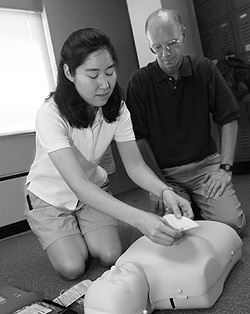Defibrillation units put heart help within reach

Dr. Sun Park practiced using a new automated external defibrillator unit under the watchful eye of Les Woolridge, R.N., education coordinator for the Resuscitation Program. (photo by Donna Jones Bailey)
Vanderbilt University Medical Center is boosting the odds of survival for anyone who experiences a heart event in non-patient care areas of the medical center.
Eight Automated External Defibrillators (AED) units are being placed at strategic points across the institution, a move that resuscitation experts say could save lives.
"The use of this device makes a tremendous difference in survival," said Ruth Vogelpohl, R.N., M.S.N., coordinator/clinical nurse specialist for the Resuscitation Program at Vanderbilt. "This is a radical departure from traditional defibrillator use, but it works. Getting a heart shocked as soon as possible is easy in patient care areas because there are emergency carts available. It's difficult to get that cart transported to a non-patient area."
The 9-by-8-inch device weighs about five pounds and is easy to operate.
"It's very simple to use," said Les Wooldridge, R.N., educational coordinator for the Resuscitation Program. "Although some training is recommended, I've seen it used by students many times with little or no orientation to it. In conjunction with the Learning Center, we've been training our medical, nursing and ancillary staff in the use of the AED for the past three years."
The unit is equipped with a voice chip that provides step-by-step instructions. Vanderbilt is one of the first hospitals in the area to place the AEDs throughout its medical facility.
"We are trying to do our part by training all hospital staff, raising public awareness and providing the equipment," Vogelpohl said.
Vogelpohl said other area businesses which have installed the devices include Nashville International Airport, Saturn and Jack Daniel's Distillery as well as every fire station in Davidson County, which puts defibrillation capability in the hands of those who respond first to emergencies.
According to Wooldridge, the quicker response time aids in the recovery of victims. Each minute that passes in full cardiopulmonary arrest means a 10 percent loss in recovery.
"Time is essential," he said. "By having easy-to-use defibrillators readily available, we hope to save lives."
AED users are covered by the Good Samaritan Act, which removes persons assisting a victim from liability.
The $2,900 units will be protected by a plexiglas case, much like fire extinguishers. Once the door is opened, a silent alarm is transmitted to the security office.
The locations of the new AED units are: hospital lobby; TVC lobby and on the second floor near the Cafeteria exit; Medical Center North lobby and Hospital Administration; Light Hall lobby, Oxford House lobby and Medical Center East lobby (level P-1).













